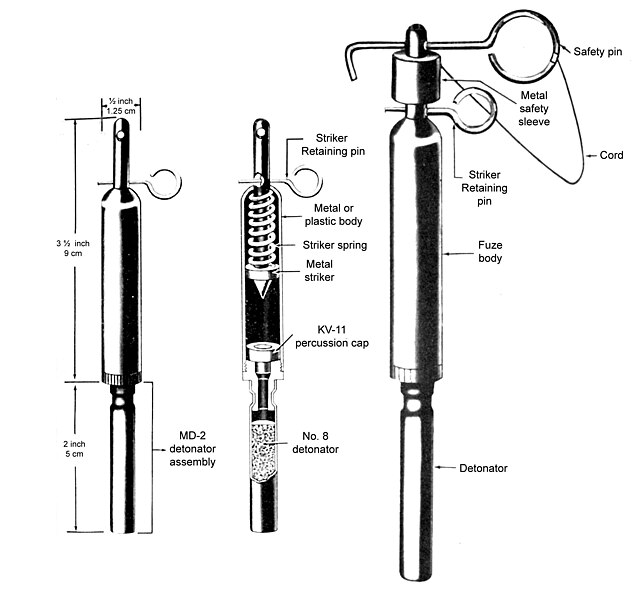Top Qs
Timeline
Chat
Perspective
F-1 grenade (Russia)
Anti-personnel hand grenade From Wikipedia, the free encyclopedia
Remove ads
The Soviet F-1 hand grenade (Russian: Фугасный 1, romanized: Fugasnyy 1, lit. 'Explosive, Type No. 1') is an anti-personnel fragmentation defensive grenade.


Remove ads
History
The F-1 was introduced during World War II and subsequently redesigned post-war.
While the F-1 is no longer regarded as a front-line weapon with the former Warsaw Pact countries, it still remains in widespread use, especially with insurgent groups.[2]
Design
Summarize
Perspective
The F-1 grenade’s body based on the French F1 grenade cast iron body and contains a 60 g (2.1 oz) explosive charge (TNT). The total weight of the grenade with the fuze is about 600 g (21 oz).[3]
Due to its shape and its yellow-green color, it is nicknamed the limonka (fem. 'little lemon'). It is also nicknamed Efka (Russian: Эфка) for the letter F.[4]
The F-1 also is similar to the American Mk 2 "pineapple grenade", which was ultimately modeled on the French F-1.
The F-1 has a steel exterior that is notched to facilitate fragmentation upon detonation and to prevent hands from slipping. The distance the grenade can be thrown is estimated at 30–45 m (98–148 ft).
The radius of the fragment dispersion is up to 200 m (660 ft) (effective radius is about 30 m (98 ft),[5]). Hence, the grenade has to be deployed from a defensive position to avoid self-harm.
About 60 percent of the grenade body pulverizes during the explosion, only 30 percent of the body splits into 290 high-velocity, sharp-edged splinters each weighing around 1 gram with an initial speed of about 700 m/s (2,300 ft/s).
Fuze
The F1 uses the UZRG-M fuze (Russian: УЗРГ-М, romanized: Universal'nyi Zapal, Ruchnaya Granata, Modernizirovannyi, lit. 'Universal igniter, hand grenade, modernized').
The UZRGM is a universal Russian type fuse also used in the RG-42 and RGD-5 grenades. The standard time delay for this fuze is 3.5 to 4 seconds.
Myth
There was a myth originating from an article written by Peter Kokalis [citation needed] for the Soldier of Fortune (magazine) that implied UZRGM fuze variants are available in versions with delays from zero (i.e., instantaneous, specifically for use in booby-traps) to 13 seconds. However the UZRGM fuze never had such variants, and all UZRGM fuzes have delay of 3.2 to 4.2 seconds if working correctly.
The myth originated from the author reading the numbers stamped on the fuze body, which are concealed when the fuze is inserted into the grenade. This number indicates the factory production line, not the fuze delay.
Having fuzes without clear external marking indicating that it is "short fuze" with 0 or 1–2 seconds delay would be dangerous for soldier operating them.[6] It is possible to hear a loud "pop" as the fuze ignites and begins to burn.
Remove ads
Variants
Training variant
URG
The URG (Russian: учебная ручная граната, romanized: Uchebnaya ruchnaya granata, lit. 'Training hand grenade') is the F-1's simulation-training variant.
Foreign copies
Several countries produced copies of the F-1 grenade, including China (as the Type 1), Bulgaria, Czech Republic, Georgia, Poland, and Romania.[7] There are different production variations according to country of origin, including fuze and explosive filling.
China
Produced locally as the Type 1 grenade[2][8] and the Type 54-2.
Poland
F1/N60 rifle grenade variant with an impact fuze instead of a time delay fuze.[7]
Ukraine
In 2024, Ukraine started production of an improved F-1 grenade which was approved for military use in September 9, 2024.[9]
Criminal usage
Several insurgent groups have produced their own grenades based on the F-1.[2]
Operators
 Bulgaria[2]
Bulgaria[2] China
China Czechoslovakia[10]
Czechoslovakia[10] Czech Republic[2]
Czech Republic[2] Georgia[11]
Georgia[11] Iraq[12]
Iraq[12] North Korea[13]
North Korea[13] Poland
Poland
- Remained in frontline service as late as 2010[7]
 Romania[11]
Romania[11] Russia[11]
Russia[11] Soviet Union
Soviet Union South Yemen
South Yemen
- 50,000 delivered between 1982 and 1987 by Czechoslovakia[10]
 Syria[14]
Syria[14] Ukraine
Ukraine
- Domestically produced copies[9]
 Vietnam[8]
Vietnam[8]
See also
References
Bibliography
External links
Wikiwand - on
Seamless Wikipedia browsing. On steroids.
Remove ads

